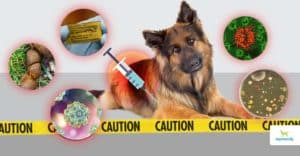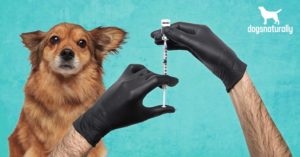Pet owners have been anxiously awaiting good news from The Rabies Challenge Fund Charitable Trust (RCF) since its founding in 2009.
And now the study has been peer-reviewed and published. At DNM we got our hands on a copy, and I’m going to tell you what it says.
First I want to give you a bit of background, in case you don’t know the history of the RCF.
Note: If you know about RCF and want to skip this part … start reading at Roadblocks, below.
How the Rabies Challenge Fund Got Started
In 2003 Kris Christine’s dog Meadow received a rabies booster. This was a 2-year booster required (at the time) by the state of Maine. There is no 2-year rabies vaccine licensed, so he got a 3-year vaccine.
Meadow developed a malignant mast cell tumor at his rabies vaccination site … and it metastasized. This tragic reaction made Kris decide to do something about the over-strict rabies vaccination laws … knowing so many dogs suffering serious damage from over-vaccination.
The first thing Kris did was to get Maine’s rabies law changed … so that cats and dogs can be vaccinated with any licensed vaccine. She also obtained a medical exemption clause.
And then she formed the Rabies Challenge Fund.
Veterinarian W Jean Dodds DVM came in as Co-Trustee. Veterinary immunology expert Ronald P Schultz DVM PhD joined as Principal Investigator to lead the studies. Dr Laurie Larson got involved upon Dr Schultz’s retirement. Both Dr Schultz and Dr Larson were from the University of Wisconsin-Madison School of Veterinary Medicine.
They set an important goal for the RCF studies.
That goal was to extend state-mandated rabies vaccine frequency from the current 3 years, to 5 years, and then 7 years.
Rabies Duration Of Immunity
Dr Schultz spent decades researching vaccine immunity at University of Wisconsin. His work showed that duration of immunity (DOI) for core vaccines was at least 7 years. And in many cases, protection lasted for the life of the pet.
Dr Schultz’s serological* studies of rabies vaccines showed that vaccinated animals were protected for 7 years.
In 1992, French researcher Michel Aubert demonstrated that dogs were immune to a rabies challenge** 5 years after vaccination.
When RCF began, Dr Jean Dodds said:
“From challenge trials, we know the DOI for regular vaccines is seven to nine years, if not longer. So why would the rabies vaccines, being so potent, not have an even longer DOI? We decided the thing to do would be to design a study to federal government standards that would determine if the DOI is longer than three years.”
Reduce Adverse Effects of the Rabies Vaccine
Rabies vaccines cause a multitude of adverse effects. These range from immediate reactions to long term, chronic illness … and even death.
Documented reactions include:
- Behavior changes (aggression, separation anxiety)
- Obsessive behavior, self-mutilation, tail chewing
- Pica – eating wood, stones, earth, stool
- Destructive behavior, shredding bedding
- Seizures, epilepsy
- Fibrosarcomas at injection site
- Autoimmune diseases of bone marrow and blood cells, joints, eyes, skin, kidney, liver, bowel or central nervous system
- Muscular weakness and or atrophy
- Chronic digestive problems
Countless animals suffer from these chronic issues. So, extending the legally required vaccine intervals would help reduce adverse rabies vaccine reactions. But it would still protect pets (and thus people) from rabies infection.
RCF designed live rabies virus challenge studies to measure the long-term duration of immunity. They expected to show that duration of immunity of rabies vaccines is much longer than 3 years.
Successful challenge studies (done according to USDA licensing code Title 9), could help convince State governments to allow longer intervals between rabies shots. RCF hoped to prove first 5 years immunity, and then 7 years.
RCF also believed their studies might prompt vaccine manufacturers to come up with rabies vaccines licensed for 5 and 7 years.
Funding
Before the studies could start, RCF had to raise money. University of Wisconsin agreed to cover nearly half of the overhead for the study. But RCF still needed $177,000 for just the first year, and $150,000 each year after that.
RCF was a true grassroots supported organization. Funding for the study came from many different sources … perhaps even from you!
Everyone wanted the research to help change outdated and sometimes draconian rabies laws.
Many individual pet owners generously gave what they could afford to help fund the studies. Breed clubs, rescue groups, trainers, breeders, and kennel owners also donated to RCF.
Roadblocks
The team ran into some unlucky obstacles along the way.
First, finding a challenge facility to do the studies wasn’t easy. Typically, only vaccine manufacturers have large scale challenge facilities that are USDA approved. Dr Schultz found a facility for the challenges. But then the company was sold and RCF was left without a lab to do the challenges.
Eventually they found a replacement facility. Dr Zhen Fang Fu of the Department of Pathology at the University of Georgia (UG) vet school agreed to run the challenge studies. But the lab could only accommodate 15 dogs at a time.
So it took longer than planned to do the trials.
Then … the USDA wouldn’t send the virus to any lab under biosafety level 3. UG’s lab was level 2. Luckily they were really keen to do the trials, so they upgraded the lab.
But it caused another delay.
Virus Failure
The third and biggest problem was that the live rabies virus used for the first challenge trial had lost its virulence. Only the USDA can supply the virus, so the researchers had to get a different virus for the remaining challenges.
You’ll read in the description of Challenge Trial 1 how this major problem impacted the success of the studies.
The Research
The study protocol followed the USDA’s Animal and Plant Health Inspection Service Title 9 CFR standards for licensing rabies vaccines.
RCF ran two concurrent studies, for 5 and 7 years.
They started with 100 female Beagle puppies. Ultimately there were 65 Beagles in the studies. 35 dogs were spayed and adopted out at the end of the studies.
There were 3 challenge groups.
- At 12 and 15 weeks old, 3 groups of dogs got either a commercial rabies vaccine, or saline.
- Challenge groups 1 and 2 had 15 dogs. Each group had 10 vaccinated dogs and 5 non-vaccinated control dogs.
- Group 3 had 12 vaccinated dogs and 3 non-vaccinated control dogs.
The two rabies vaccines were:
- Continuum Rabies (“Vaccine A”), by Intervet (Merck)
- IMRAB- TF (“Vaccine B”), a thimerosal-free vaccine by Merck.
A third rabies vaccine was used for the Revaccination Trial. I’ll explain that later.
The Rabies Challenge Trials
Before we talk about the results, here’s how the researchers did the challenge trials.
“Challenge” means they injected live rabies virus into the dogs, under anesthesia.
Then, every 8 hours for 28 days, they observed the dogs for signs of rabies, including:
- Hyper excitability
- Behavior changes
- Dilated pupils
- Photophobia (light sensitivity)
- Reduced appetite
- Inability to drink
- Vomiting
- Incoordination
If dogs showed any of these early signs of rabies, they immediately and humanely euthanized them. The dogs were never allowed to develop full-blown rabies.
After the initial 28-day observation period, the researchers monitored survivors daily for the rest of the 90-day period.
The goal was to meet the USDA Code Of Federal Regulations (CFR) Title 9 … which require an 88% or higher survival rate.
Challenge Trial # 1
The first challenge included 15 dogs:
- 5 unvaccinated control dogs
- 5 dogs vaccinated with Vaccine A, challenged 6 years 10 months after vaccination
- 5 dogs vaccinated with Vaccine B, challenged 5 years 5 months after vaccination
This challenge was “confounded” (unfortunately this means it failed!) … because of “insufficient virulence” of the challenge virus used. The virus came from the USDA … that’s the only way for researchers to obtain it.
- None of the vaccinated dogs got rabies
- Only 2 of 5 unvaccinated dogs showed signs of rabies.
The researchers are confident that if they’d had a sufficiently virulent virus, the trial would have met the USDA’s 88% survival requirement for rabies vaccination.
But of course we don’t know that for sure.
The researchers obtained a different rabies challenge virus from the USDA for the remaining challenges.
Challenge Trial # 2
Challenge 2 was also done with 15 dogs.
- 5 unvaccinated control dogs.
- 5 dogs vaccinated with Vaccine A, challenged 8 years after.
- 5 dogs vaccinated with Vaccine B, challenged 6 years 7 months after.
In trial 2, all of the 5 unvaccinated dogs showed signs of rabies within 13 to 21 days of challenge.
This meant the rabies virus was sufficiently virulent this time. (They used the same one for Trial 3.)
- Only 1 of 5 of the Vaccine A dogs showed protection against rabies (8 years after vaccination).
- 4 of 5 Vaccine B dogs showed protection against rabies, 6 years 7 months after vaccination.
- So … half of the 10 vaccinated dogs were protected. None of these 5 protected dogs developed clinical signs of rabies during the 90-day observation period.
Challenge Trial # 3
For humane reasons the researchers reduced the number of unvaccinated dogs in this trial:
- 3 unvaccinated control dogs
- 12 dogs vaccinated with Vaccine B, challenged 7 years 1 month after vaccination.
To spare lives … only Vaccine B dogs were in Trial 3. That was because in Trial 2, the survival rate of Vaccine A dogs was only 20%.
- Again, all unvaccinated dogs showed signs of rabies 14 to 21 days after the challenge.
- 6 of 12 vaccinated dogs survived the 90-day observation period with no signs of rabies.
Final Rabies Challenge Study Results
Again, Trial 1 failed because the challenge virus wasn’t sufficiently virulent,
So … I’m just summarizing Trials 2 and 3 …
- 80% (of vaccinated dogs) showed protection after 6 years 7 months
- 50% showed protection after 7 years 1 month
- 20% (1 dog) showed protection after 8 years
This means:
- The research did demonstrate that rabies duration of immunity is greater than 3 years. (Remember, they used vaccines licensed for 3-year use.)
- The research did not achieve its goal of 88% survival rates, 5 years or 7 years after vaccination.
- The trial 2 results showing 80% of dogs were protected by Vaccine B were encouraging … but not enough to meet the USDA Title 9 standard.
So those are the final results of the challenge trials.
It’s disappointing that the 5-year challenge (Trial 1) was unsuccessful because of the non-virulent virus. It’s highly likely they would have demonstrated immunity 5 years after vaccination otherwise.
As well as the challenge trials, the studies included some important immune response testing. So … read on for more detail!
And I’ve provided some additional thoughts in the Conclusion below.
Testing For Immune Response
As part of the challenge trials, the researchers also collected regular serum and lymph node mononuclear cell samples to test immune memory responses in the dogs. They analyzed:
- Serum samples using the RFFIT rabies titer test.
- Memory cell response by flow cytometry.
- Brain tissue for the presence of rabies virus using immunohistochemistry and reverse transcriptase-polymerase chain reaction (RT-PCR).
The purpose of this immune response testing was to establish a rabies antibody titer standard for protection against the disease. This standard doesn’t currently exist … although there is a standard for humans, under the CDC’s Advisory Committee on Immunization Practices (ACIP).
This would allow vets to confirm immune response by titer so they could be confident of rabies protection when writing exemptions for unhealthy dogs.
This is especially important for seriously ill or immune-compromised dogs. Immune-compromised dogs are unlikely to mount an immune response, even if vaccinated.
Test Results
- The study found that antibody responses (measured by titers) 12 days after the challenges correlated strongly with survival.
- Vaccinated dogs had significantly higher memory B-cells 4 days after challenge, compared to the unvaccinated dogs.
- All unvaccinated control dogs had virus in their brain tissues
- All vaccinated dogs who developed rabies had virus in their brain tissues.
- Vaccinated dogs who survived the 90-day post-challenge period had no rabies virus in their brain tissues.
Unfortunately, the study did not prove a protective rabies titer standard.
This was disappointing … but didn’t really surprise the researchers. Dr Schultz had been taking titer data annually … so they’d seen how titers waned.
It did show that B-cell immunity lasts even after titers drop below a titer level of 0.1 IU/ml.
But the risk of rabies increases if titers fall below 0.5 IUI/ml.
So, rabies boosters may still be “the prudent, safe decision,” according to prior studies.
And unfortunately, for now, the law says those boosters have to be every 3 years.
The researchers also did a revaccination trial.
Revaccination Trial
10 dogs were revaccinated with Vaccine A, 6 years 1 month after their first vaccines.
Another 10 previously unvaccinated dogs got either Vaccine A, or Vaccine C, PureVax Rabies by Merial. That’s the third vaccine I mentioned earlier.
Vaccine C is a recombinant, non-adjuvanted feline rabies vaccine.
- Recombinant means 2 viruses are spliced together.
- PureVax contains rabies recombinant canarypox virus, intended to stimulate a better immune response.)
The researchers chose Vaccination C (off-label for dogs) for the Revaccination Trial because none of the dogs had had it previously. This would allow them to differentiate dogs with immune memory more easily than with Vaccine A.
The other thing that’s significant about Vaccine C is that it has no adjuvants. This means it’s less likely to cause adverse reactions.
There is no non-adjuvanted vaccine for dogs.
Revaccination Results
- 90% of the previously vaccinated dogs had titers over 0.5 IU/ml …
- … Compared to only 30% of the previously unvaccinated (naïve) dogs
- The recombinant, non-adjuvanted vaccine (C), had much higher responses than the killed virus vaccine in the previously vaccinated dogs.
- Vaccine C did not produce titers over 0.5 IU/ml in the naïve dogs.
The Revaccination Trial showed antibody response 6 years 1 month after initial vaccination was much higher than in the previously unvaccinated dogs.
In Conclusion …
The Rabies Challenge Fund has finished its work. The website states:
“We are no longer taking donations. Thank you for your support.”
The research paper concludes:
- Rabies vaccine may induce a duration of immunity well beyond 3 years in dogs
- Antibody is the most important protective factor against rabies virus
- Anamnestic responses to virulent challenge can be seen even without protective titers in previously vaccinated dogs
- Protection persists without annual or triennial re-vaccination
- Antibody testing of individual pets can be an excellent indicator of protection or lack thereof … although further studies are needed to determine a protective antibody threshold for vaccinated dogs.
But the trials did provide some hope for change in the future.
The RCF believes their research serves as a foundation for further studies (possibly by vaccine manufacturers) with the goal of:
- Licensing a rabies vaccine for 5 to 6 years. This would enable States to extend the legally required booster intervals.
- Developing and licensing a recombinant, non-adjuvanted rabies booster vaccine for dogs
- Establishing a protective serum rabies titer standard for dogs.
The RCF believes their research serves as a foundation for further studies (possibly by vaccine manufacturers) with the goal of:
- Licensing a rabies vaccine for 5 to 6 years. This would enable States to extend the legally required booster intervals.
- Developing and licensing a recombinant, non-adjuvanted rabies booster vaccine for dogs
- Establishing a protective serum rabies titer standard for dogs.
Clearly the results were not what we’d all hoped. The rabies vaccination laws won’t be changing anytime soon.
But there are a couple of important details.
- Many of us have believed that one rabies vaccination is enough to protect a dog for many years, possibly even for life. But the RCF studies did not prove that.
- The vaccinated dogs in the RCF studies all had two rabies vaccines (at 12 and 15 weeks of age). So the researchers weren’t trying to prove a “one and done” theory.
- Rabies vaccines, which used killed virus, don’t create as long a DOI as modified live vaccines (like parvovirus or distemper) do.
The study did show that fully vaccinated dogs who’ve had their first two initial rabies vaccinations should have solid protection for far longer than 3 years.
So, for your own peace of mind … if you choose not to vaccinate your dog for rabies, you might want to get titers done. Then you won’t have to worry if your dog tangles with the local wildlife.
2. The studies were done to meet USDA standards for vaccine licensing,
- This means the dogs were injected directly with the rabies virus.
- That kind of challenge is quite different from your dog meeting a rabid raccoon in your backyard.
- It’s unlikely that any dog outside of a research facility would ever encounter the level of potent rabies challenge that the trial dogs did.
The Revaccination Trial showed that, even if your dog’s rabies vaccine has expired … a booster should restore his protection. In fact, a few years ago, Kansas State University found the same thing in a rabies titer study they did.
So the recommendations for veterinarians in the 2016 Compendium of Animal Rabies Prevention and Control were updated. Since then, the guidelines say that if a dog exposed to rabies is overdue for his rabies vaccination, he can have a booster shot, followed by an observation period at home, instead of being euthanized or quarantined.
Does Your Dog Still Need A Rabies Vaccine?
For now (if you want to obey the law) … you’ll still need to vaccinate your dog for rabies every 3 years in the US and most Canadian provinces.
Unless you can get a vet to write you an exemption.
Vaccine exemptions are allowed in 18 US states (with a 19th coming in May).
You’ll need to find a vet who’s willing to give the exemption. Many conventional vets aren’t comfortable with exemptions. So, try to find a holistic vet who’ll be more likely to support your request.
Even though most state legislation doesn’t allow rabies titers in lieu of vaccination … it’s a good idea to get a titer if you’re asking your vet for an exemption.
States With Exemptions
18 (soon to be 19) US States allow medical exemptions in lieu of rabies vaccination.
Alabama, California, Colorado, Connecticut, Delaware, Florida, Illinois, Maine, Massachusetts, Maryland, New Hampshire, New Jersey, Nevada, New York, Oregon, Pennsylvania, Vermont, Virginia, Wisconsin.
Each state’s law is different, but in most cases, it means your vet can write an exemption for a pet who isn’t healthy enough to be vaccinated.
In January 2020, Delaware passed a new bill authorizing exemptions. Delaware is unique in that the law specifically provides for rabies titers for pets considered unhealthy. The bill should be signed into law in May 2020.
If your state doesn’t already allow exemptions … think about whether you’d like to get involved and help make changes.
Comments From the Rabies Challenge Fund (RCF)
RCF Co-Trustee and founder, Kris Christine was kind enough to share her thoughts with me on the trial results.
“We’ve collected data that has the potential to make the US a safer place for our canines. I’m really happy we were able to do what we did … despite the hurdles.
“I want to thank every single person who donated. Especially those individuals who gave whatever they could afford … even $5 a month … because they believed so strongly in our work.
“I feel this was my way of giving back to these incredible animals who bring us so much. Whatever sanity I have is because of dogs! In these difficult times with COVID, things would be so much worse without dogs They keep us grounded and somewhat sane.
“I hope this data will help ease the draconian approach to enforcing regulations. We need more reasonable regulations and protocols, based on science and not just fear!”














